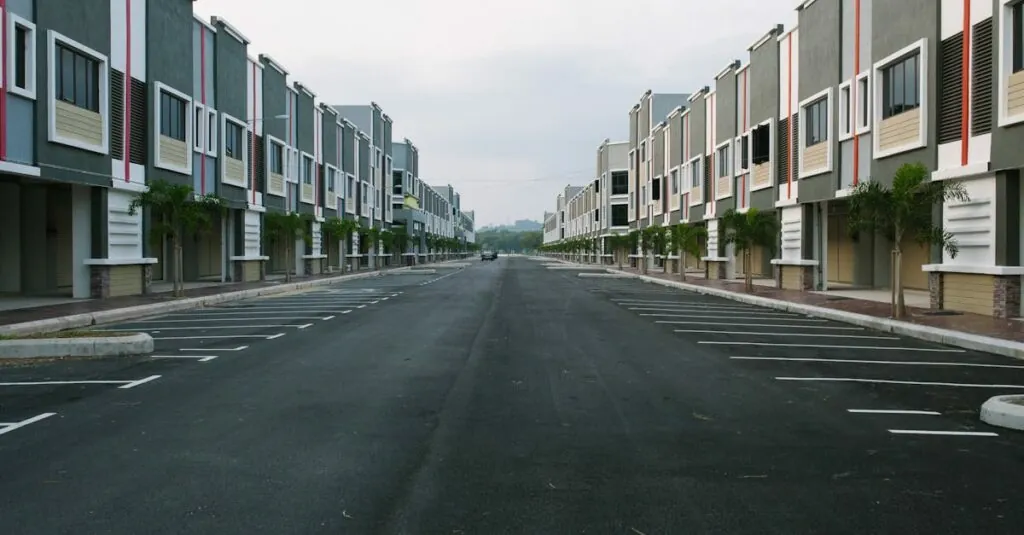Table of Contents
ToggleVacant properties might seem like a golden opportunity, but they can quickly turn into a financial black hole. Picture this: a charming little house sitting empty, waiting for its moment to shine. Instead of turning into a dream investment, it’s racking up vacant property taxes faster than you can say “real estate.” Who knew that owning a piece of prime real estate could feel like hosting a party no one shows up to?
Understanding Vacant Property Taxes
Vacant property taxes serve as a mechanism to address the prevalence of unoccupied properties. These taxes aim to discourage property owners from leaving their buildings idle.
Definition of Vacant Property Taxes
Vacant property taxes refer to additional levies imposed on properties that remain unoccupied for a predetermined period, often six months. Municipalities assess these taxes as a means to incentivize property owners to either occupy, rent, or sell their vacant properties. The tax amount typically varies based on local regulations and property value, reflecting the community’s commitment to revitalization and land use efficiency.
Purpose and Goals of Implementation
Local governments implement vacant property taxes to mitigate urban blight and encourage property maintenance. Establishing these taxes aims to reduce the negative impact of vacant properties on neighborhoods, such as decreased property values and increased crime rates. Municipalities seek compliance by creating financial disincentives for property owners who delay addressing vacancy issues. Engaging property owners with these taxes fosters community stability and revitalization initiatives.
The Impact of Vacant Property Taxes
Vacant property taxes play a crucial role in shaping local communities and property markets. Their implementation leads to several notable effects.
Economic Effects on Local Communities
Vacant property taxes generate revenue that local governments invest in community programs. Programs funded by this revenue improve public services, infrastructure, and neighborhood safety. Reduced vacancies can stimulate local economies, leading to more foot traffic and business opportunities. Businesses benefit from increased patronage, which results in job creation. Additionally, neighborhood revitalization becomes possible, attracting more residents and encouraging long-term stability.
Influence on Property Value and Development
Property values often decrease in areas with high vacancy rates. Vacant properties contribute to a perception of neglect, decreasing surrounding property values as well. In contrast, vacant property taxes incentivize owners to rehabilitate or sell their properties, leading to redevelopment efforts. These efforts enhance appeal and desirability, leading to improved property valuations. Ultimately, revitalized areas attract investors, promoting a thriving real estate market and fostering overall growth.
Key Features of Vacant Property Taxes
Vacant property taxes contain several important characteristics that affect property owners and local communities. Understanding these features aids in navigating the implications of holding unoccupied properties.
Assessment Methods
Cities utilize various assessment methods to identify vacant properties. Often, local governments examine property records, occupancy status, and tax payment histories. Property owners might also receive periodic inspections to verify occupancy levels. Municipalities may apply a specified timeframe, typically of six months, to classify a property as vacant. Additionally, they can implement penalties based on these assessments to enforce compliance. Assessments aim to provide accurate information to ensure proper tax levying, promoting transparency and fairness in property taxation.
Exemptions and Reductions
Local governments frequently offer exemptions and reductions on vacant property taxes. Various factors, including property type or the owner’s financial status, may qualify properties for relief. For example, properties facing extensive renovations or legal complications could receive temporary tax exemptions. Moreover, nonprofit organizations or low-income housing initiatives may qualify for reduced rates. Property owners must apply for these exemptions through designated forms or processes. Awareness of available exemptions can significantly alleviate the tax burden for property owners holding vacant assets.
Case Studies of Vacant Property Taxes
Various municipalities provide insights into the implementation of vacant property taxes and their impacts. Different strategies yield different results across regions, showcasing the complexities of managing vacant properties.
Successful Implementations
In places like Philadelphia, the vacant property tax generated substantial revenue, funding revitalization projects. Properties remained vacant less time, as owners repaired and rented them instead. Successful outcomes in this city led to neighborhood improvements and increased engagement from property owners. Chicago also implemented a vacant property tax that decreased vacancy rates significantly, improving overall community safety. These measures not only returned properties to productive use but also bolstered local economies through increased tax revenue.
Challenges Faced by Municipalities
Though beneficial, municipalities face challenges implementing vacant property taxes. Resistance from property owners often emerges, leading to legal disputes regarding tax assessments. Communicating the purpose of these taxes becomes critical for acceptance. Additionally, identifying truly vacant properties poses a logistical hurdle; cities require accurate data to ensure compliance. Not all properties suit standard assessments, complicating enforcement efforts further. Finally, municipalities must balance these initiatives with community needs, ensuring that remedies do not create further financial strain for property owners.
Conclusion
Vacant property taxes serve as a critical tool for municipalities striving to combat urban decay and promote community revitalization. By imposing financial penalties on unoccupied properties, local governments encourage owners to take action, whether that means renting, selling, or renovating their assets. This proactive approach not only helps reduce vacancy rates but also stimulates local economies and enhances neighborhood safety.
Understanding the implications of these taxes is vital for property owners. Awareness of potential exemptions can significantly lessen their financial burden. As cities continue to implement and refine vacant property tax policies, the benefits for communities and local markets will likely become even more pronounced.







